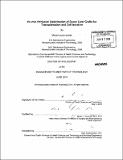Ex vivo perfusion optimization of donor liver grafts for transplantation and cell isolation
Author(s)
Izamis, Maria-Louisa, 1979-
DownloadFull printable version (21.63Mb)
Other Contributors
Harvard University--MIT Division of Health Sciences and Technology.
Advisor
Martin L. Yarmush.
Terms of use
Metadata
Show full item recordAbstract
There is a constant demand for enormous numbers of high quality hepatocytes in the fields of cell transplantation, pharmacotoxicology, tissue engineering, and bioartificial assist devices. The scarcity of viable hepatocytes necessitates the use of suboptimal sources including damaged donor organs that are not transplantable. Many of these organs have potentially reversible pathologies however, that could be treated via ex vivo perfusion thereby increasing their cell yield. With the intent to translate organ recovery by perfusion into the clinic, we engineered a very simple room temperature-operated ex vivo organ perfusion system to test a rat liver model of uncontrolled non-heart beating donors. Seventeen times as many hepatocytes were recovered from livers exposed to an hour of warm ischemia (WI, 34*C) compared to untreated WI livers in only 3 hours of perfusion. Further, fresh liver hepatocyte yields were also increased by 32% postperfusion, demonstrating that both damaged and healthy donor livers could benefit from this methodology. A linear correlation between cell yield and tissue ATP content was established. This enables an accurate prediction of cell recovery during preservation and can be used as a direct measure of organ viability and the trajectory of organ recovery during perfusion resuscitation. Further, a strong correlation between perfusion flow rate and cell yield was also established supporting the use of flow rates as low as possible without causing hypoperfusion or oxygen deprivation. Morphologically and functionally, perfusion-isolated hepatocytes generally performed comparably or better than fresh hepatocytes in cell suspension and plate culture. Cumulatively, these findings strongly support the ubiquitous use of organ perfusion systems in the clinic for optimal enhancement of donor grafts.
Description
Thesis (Ph. D.)--Harvard-MIT Division of Health Sciences and Technology, 2010. Cataloged from PDF version of thesis. Includes bibliographical references.
Date issued
2010Department
Harvard University--MIT Division of Health Sciences and TechnologyPublisher
Massachusetts Institute of Technology
Keywords
Harvard University--MIT Division of Health Sciences and Technology.